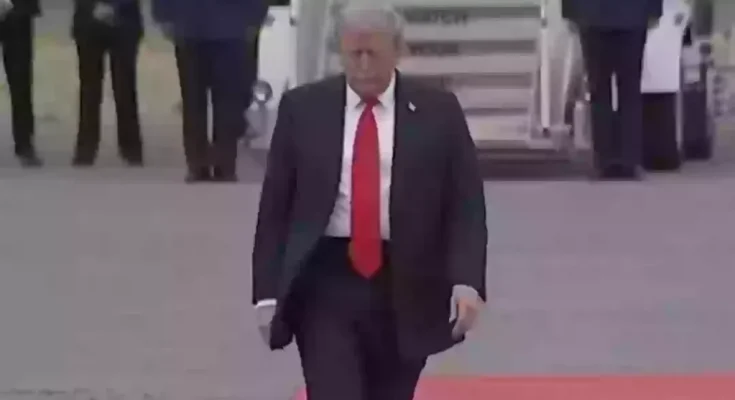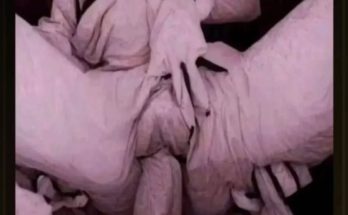Footage from multiple outlets showed Trump exiting Air Force One, waving briefly, then stepping onto the red carpet. As he made his way forward, instead of following a straight line, he appeared to veer subtly left and right. To some viewers, it looked awkward. To others, it looked calculated.
On social media, speculation erupted. Many drew connections to the two assassination attempts Trump has survived in the past year, including the shooting that left him wounded and another plot foiled just two months later.
One Twitter user wrote bluntly: “SURVIVAL: Just last year Trump was shot by an assassin and narrowly escaped a second attempt on his life two months later. The zig-zag pattern is the very best way to frustrate an assassin’s bullet.”
Another joked while making a similar point: “As a Fortnite professional I can tell you he is avoiding potential sniper fire.”
Others backed the idea with military reasoning, noting that zig-zagging is a classic manoeuvre for high-value targets in open spaces. “Likely targets of long-range snipers are often directed to walk in a zig-zag pattern to decrease the effectiveness of future attacks,” one person observed.
Health speculation
Not everyone was convinced it was about security. Some suggested the unusual walk might be down to Trump’s health. In recent months, reports have circulated about his chronic venous insufficiency (CVI) diagnosis, a condition affecting circulation in the legs.
The Cleveland Clinic defines CVI as a disorder that develops when leg veins are damaged and can’t pump blood effectively. Symptoms can include swelling around the ankles, aching or heavy legs, and discomfort when walking.
Miami Vein & Wellness notes that CVI can directly impact a person’s gait: “If you have CVI, your ankles may swell and your calves may feel tight. Your legs may also feel heavy, tired, restless, or achy. You may feel pain while walking or shortly after stopping.”
For some watching, Trump’s zig-zagging wasn’t a tactic against snipers — it was the visible effect of his medical condition.
Assassination fears linger
The assassination attempt at a Pennsylvania rally last year continues to shape perceptions of Trump in public. That event, where a bullet grazed his ear, remains etched in the American psyche. A second incident — an alleged gunman intercepted before reaching Trump at a Florida fundraiser — only heightened concerns.
Security experts say such experiences often lead to changes in behaviour. Protectees sometimes adopt habits, consciously or not, that make them feel safer in exposed environments. The zig-zag pattern may have been Trump’s own instinct, a Secret Service directive, or simply coincidence. But given his history, many believe it was deliberate.
The fact that this meeting with Putin was staged under such intense global scrutiny only amplified the reactions. Every move, every gesture, every handshake carried layers of meaning for analysts and the public alike.
Online reaction
Theories flourished across platforms, ranging from the serious to the absurd. Memes quickly appeared comparing Trump’s walk to video game characters dodging sniper fire. Others spliced the footage with training clips of soldiers practising evasive manoeuvres.
But for his supporters, the zig-zagging walk was reframed as proof of Trump’s resilience. Having already survived multiple threats, he was portrayed as a man taking nothing for granted and refusing to make himself an easy target.
Critics, meanwhile, argued the moment symbolised weakness rather than strength — a leader unable to stride confidently at the very moment he was trying to project dominance on the world stage.
The bigger picture
Trump’s meeting with Putin was always going to be remembered for its imagery as much as its content. The handshake on the tarmac, the military flyover of stealth bombers, and the lavish meal behind closed doors all fed into narratives about power, theatre, and diplomacy.
Now, the zig-zag walk has joined that list — an unscripted moment layered with symbolism. Whether it was a survival tactic, a health-related symptom, or a quirk magnified by online speculation, it has already become one of the standout visuals from the Anchorage summit.
Conclusion
Theories about Trump’s zig-zagging gait reflect the uncertainty and division that still surround him. To some, it was the mark of a man who knows he is a target and has learned to adapt. To others, it was evidence of frailty, a health condition shaping his movements at a critical time.
What’s certain is that nothing about the summit escaped scrutiny. From leaked schedules to body language breakdowns, every detail was dissected for meaning. And in the end, the way Donald Trump walked down a red carpet became as much a topic of conversation as what he and Vladimir Putin actually said behind closed doors.



